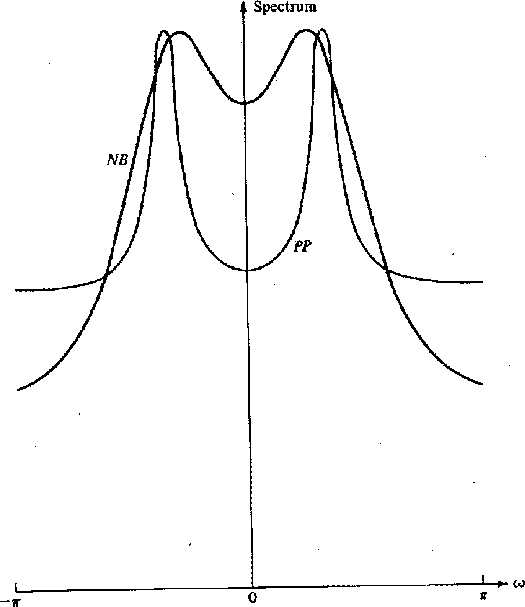In some applications it is desired to reject
a very narrow frequency band leaving the rest
of the spectrum little changed. The most common
example is 60-Hz noise from power lines.
Such a filter can easily be made with a slight
variation on the all-pass filter. In the all-pass filter
the pole and zero have an equal (logarithmic) relative
distance from the unit circle. All we need to do is
to put the zero closer to the circle. In fact,
there is no reason why we should not put the zero right
on the circle. Then the frequency at which the zero is
located is exactly canceled from the spectrum of
input data. If the undesired frequency need not be
completely rejected, then the zero can be left just inside
or outside the circle. As the zero is moved farther
away from the circle, the notch becomes less deep until
finally the zero is farther from the circle than the pole
and the notch has become a hump. The resulting filter
which will be called pole on pedestal is in many
respects like the narrowband filter discussed earlier.
Some of these filters are illustrated in Figures 18
and 19. The difference between the pole-on-pedestal
and the narrowband filters is in the asymptotic behavior
away from ![]() . The former is flat, while the latter
continues to decay with increasing
. The former is flat, while the latter
continues to decay with increasing
![]() . This makes the pole on
pedestal more convenient for creating complicated filter
shapes by cascades of single-pole filters.
. This makes the pole on
pedestal more convenient for creating complicated filter
shapes by cascades of single-pole filters.
|
2-18
Figure 18 Pole and zero locations for some simple filters. Circles are unit circles in the Z plane. Poles are marked by X and zeros by 0. |  |
|
2-19
Figure 19 Amplitude vs. frequency for narrowband filter (NB) and pole-on-pedestal filter (PP). Each has one pole at |  |
Narrowband filters and sharp cutoff filters should be used with caution. An ever-present penalty for such filters is that they do not decay rapidly in time. Although this may not present problems in some applications, it will do so in others. Obviously, if the data collection duration is shorter or comparable to the impulse response of the narrowband filter, then the transient effects of starting up the experiment will not have time to die out. Likewise, the notch should not be too narrow in a 60-Hz rejection filter. Even a bandpass filter (easier to implement with fast Fourier transform than with a few poles) has a certain decay rate in the time domain which may be too slow for some experiments. In radar and in reflection seismology the importance of a signal is not related to its strength. Late-arriving echoes may be very weak, but they contain information not found in earlier echoes. If too sharp a frequency characteristic is used, then filter resonance from early strong arrivals may not have decayed sufficiently by the time that the weak late echoes arrive.